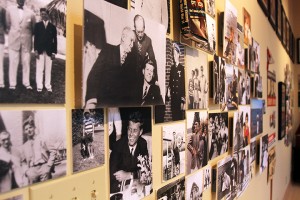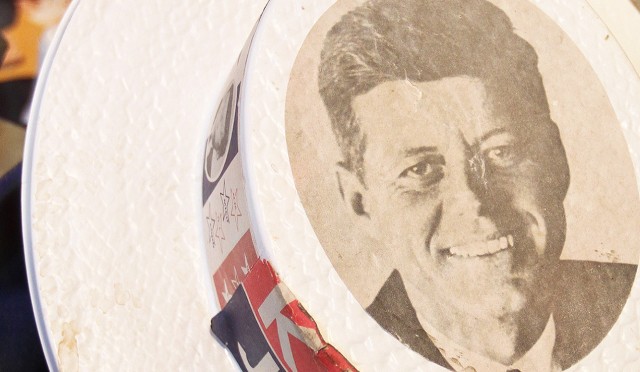
Travis Taylor | Lariat Photo Editor
Staff Writer
This November, it will have been 50 years since President John F. Kennedy was assassinated, and W.R. Poage Legislative Library is honoring Kennedy’s life and legacy with an exhibit that will last through May 2014.
The exhibit opened to the public on Sept. 3 on the first level of the library, featuring numerous artifacts and photographs relevant to Kennedy’s life. Ben Rogers, director of W.R. Poage Legislative Library, said the exhibit is divided into three sections: Kennedy’s life, his legacy and his assassination.
Objects like press camera models and bullets of the same type as those used on the day of the assassination are available to view, along with newspapers from Waco, Dallas and many other publications.
Kennedy campaign buttons and posters have been donated and are on display, as well as teletypes from the Associated Press and United Press International from the time of the attack.
The exhibit also displays a vinyl LP record donated by a radio broadcaster of recorded quotes from Lee Harvey Oswald himself. The back of the album cover reads, “Was Oswald insane? Listen and judge for yourself.”
Rogers said one thing the library has that can be found nowhere else is a letter from the priest who read Kennedy’s last rites. The letter describes how the priest, Father Oscar L. Huber, perceived those moments that surrounded reading the rites, along with a page from the book which he used to read the rites.
“I will never forget the blank stare in her eyes and the sign of agony on her face,” Huber said in his letter of the president’s wife, Jacqueline Kennedy.
The items on exhibit have been donated from people across the nation, Rogers said.
Much of the exhibit is also dedicated to the research done around the assassination of Kennedy, including glass slides, an analytical drawing and writings that have been made by various professionals over decades.
The exhibit also highlights many different theories that have arisen over time about the reasons Kennedy was killed.
“Did the Cubans do it, did the government do it, did Lyndon B. Johnson do it, was the KGB behind it, was the Mafia, UFO cover-up theories; there are all kind of wild theories, and some of them certainly have put together a good list of background material that would support their viewpoint,” Rogers said.
Rogers said one reason the Kennedy assassination holds public interest is that it grabs a person’s imagination.
“It just may be the mystery of the ages, like who built the pyramids,” Rogers said.
Erik Swanson, Moorpark, Calif., museum studies graduate student, is a graduate assistant at the library and has been working with the exhibit.
“I think it’s hard for us to rationalize why one person would just kill another person for no reason – especially someone like JFK,” Swanson said. “He kind of became mythicized after he died because he was obviously a very popular president. And the fact that he was cut down so young — there’s no really one explanation. It’s more just a big question of ‘why.’”
The section of the exhibit concerning Kennedy’s legacy pays homage to his work in the arts, his creation of the Peace Corps and his role in the initiation of the Civil Rights Movement and the space program.
“We wanted students to know what is the result of President Kennedy’s three years in office,” Rogers said.
The section on Kennedy’s life shows photographs of him with his family and of him serving in the military during World War II.
“We thought Baylor students would not be familiar with the history of President Kennedy and that era of U.S. history, which is what Kennedy referred to as ‘the American Camelot,’” Rogers said.
Swanson said it’s easy to overlook what Kennedy did in his presidency because his term was cut short “so terribly” by his assassination.
The exhibit is free and open to the public. More information can be found by visiting baylor.edu/lib/poage.


